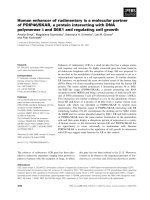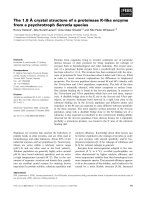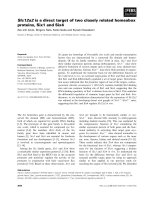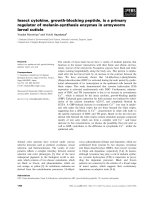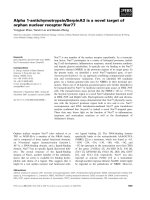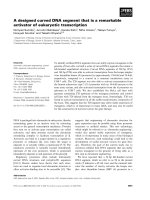C elegans PRDM1 blimp1 homolog BLMP 1 is a positive regulator of bed 3 transcription
Bạn đang xem bản rút gọn của tài liệu. Xem và tải ngay bản đầy đủ của tài liệu tại đây (2.86 MB, 85 trang )
C. elegans PRDM1/Blimp1 homolog BLMP-1 is a positive
regulator of bed-3 transcription
YANG JIN
(B.SCI, ZJU)
A THESIS SUBMITTED
FOR THE DEGREE OF MASTER OF SCIENCE
DEPARTMENT OF BIOCHEMISTRY
NATIONAL UNIVERSITY OF SINGAPORE
2014
DECLARATION
I hereby declare that the thesis is my original work and it has been written by me in its
entirety.
I have duly acknowledged all the sources of information which have been used in the
thesis.
This thesis has also not been submitted for any degree in any university previously.
Yang Jin
22 January 2014
i
Acknowledgements
I thank my supervisor, Assistant Professor Takao Inoue, for his continual and patient
guidance, support and assistance throughout the entire course of my studies as a graduate
student, and for his critical reading and comments on the manuscript. I thank Jason Tan Wei
Han and Xie Zhengyang, for their preliminary work on the project. I also thank other members
of the lab, Shen Y.Q., Goh K.Y., Poh W.C., Cheng H.Y., Low N., N.W.Ng., and Y.M.Than, for
their excellent technical aid and helpful discussions. I also thank NUS, for awarding me the
NUS Research Scholarship.
Most of the strains used in this study were kindly supplied by the Mitani Lab and the
Caenorhabditis Genetics Center, which is funded by the National Institute of Health, National
Center for Research Resources.
ii
Table of Contents
Abstract (Summary)............................................................................................................v
List of Tables ......................................................................................................................... vii
List of Figures and Illustrations ............................................................................... viii
List of Abbreviations and Symbols.............................................................................x
Introduction ..............................................................................................................................1
Materials and methods ......................................................................................................6
C. elegans strains, alleles and transgenic lines ................................................................ 6
Extrachromosomal array .................................................................................................... 8
Plasmid construction ........................................................................................................... 8
Plasmids for microinjection ............................................................................................... 8
Plasmids for expressing BLMP-1 fusion protein ............................................................. 10
Strain construction ............................................................................................................ 11
Construction of transgenic strains with the blmp-1 mutant background .......................... 11
Constructing lin-35; Pbed-3::gfp and tam-1; Pbed-3::gfp mutants................................. 12
Constructing lin-53(n833) dpy-5(e61); ayIs2 and lin-53(n833) dpy-5(e61); ccIs4251;
dpy-20(e1282) mutants .................................................................................................... 13
Fusion PCR ........................................................................................................................ 15
Mutating putative BLMP-1 binding site on SF2 .............................................................. 15
Mutating putative BLMP-1 binding site on SF2-9 .......................................................... 15
RNAi ................................................................................................................................... 18
Observation of bed-3(sy705)-like phenotypes............................................................... 19
Molting defects ................................................................................................................ 19
Vulval cell count .............................................................................................................. 19
Microscopy......................................................................................................................... 20
Fusion protein expression and purification .................................................................... 20
Fusion protein expression ................................................................................................ 20
Fusion protein purification ............................................................................................... 21
EMSA ................................................................................................................................. 22
iii
Bioinformatics ................................................................................................................... 23
Image processing ............................................................................................................... 24
Results ........................................................................................................................................24
BLMP-1 activates endogenous bed-3 transcription ...................................................... 24
BLMP-1 does not regulate Pbed-3::gfp expression through the TAM-1/LIN-35-related
mechanism ....................................................................................................................... 24
Further characterization of the bed-3 intron 3 enhancer element..................................... 28
The enhancer activity of SF2-9 needs specific putative BLMP-1 binding motifs ........... 33
BLMP-1 is required for the enhancer activity of sub-fragments of NspI......................... 36
Identification of other chromatin factors involved in bed-3 expression .......................... 41
The blmp-1 mutation causes phenotypes observed in bed-3(sy705) mutants .................. 45
BLMP-1 directly binds to bed-3 in vitro ........................................................................ 50
Expression and Purification of BLMP-1 DNA binding domain ...................................... 50
BLMP-1 binding to motifs A and B................................................................................. 53
Discussion .................................................................................................................................58
BLMP-1 is a positive regulator of bed-3 ........................................................................ 58
BLMP-1 does not reduce Pbed-3::gfp expression through the TAM-1/LIN-35-related
mechanism........................................................................................................................ 58
BLMP-1 directly binds to the bed-3 enhancer element in vitro ....................................... 58
Reducing BLMP-1 causes phenotypes observed in bed-3(sy705) mutant........................ 60
Other chromatin factors possibly involved in bed-3 transcription regulation are
identified…………………………………………………………………………...61
References ................................................................................................................................62
iv
Abstract (Summary)
As a master regulator that induces B lymphocytes to terminally differentiate into plasma cells
in humans, the function of Blimp1 protein has been widely investigated. C. elegans is a model
system in which a better understanding of conserved mechanisms can be obtained with relative
ease. Hence, in this study, we focused on the regulatory role of BLMP-1, the ortholog of Blimp1
in C. elegans, to learn more about this important family of proteins and possibly to obtain novel
insights into Blimp1 function in other organisms. The C. elegans bed-3 gene was reported to
regulate molting and the vulval precursor cell division pattern, but the mechanism that controls
the expression of bed-3 was unknown. Previously, researchers found that an NspI fragment in
the bed-3 gene between intron 2 and exon 5 contained an enhancer activity and our lab further
localized the enhancer element to a 400bp region named SF2. In a large scale ChIP-Seq study
done by the modENCODE project, BLMP-1 was found to have a putative binding site in bed3 intron 3. Furthermore, our lab found that the expression of a bed-3 reporter was significantly
down-regulated by a blmp-1 mutation and blmp-1 RNAi. These results raised the possibility
that BLMP-1 may be the regulator which controls the expression of bed-3 in C. elegans. Here
we identified the exact BLMP-1 binding sites by in vitro EMSA assays. These sites are located
within a 200bp SF2-9 region located within bed-3 intron 3, the smallest region we identified
containing the enhancer activity. In addition, loss of these motifs completely abolished the
enhancer activity of the SF2-9 region. We also found that disrupting BLMP-1 function caused
molting defects and vulval cell division pattern abnormality similar to bed-3 mutants, which
provide additional evidence for BLMP-1 functioning as a transcriptional activator of bed-3. We
v
also identified other chromatin factors that may be involved in bed-3 expression. The role of
BLMP-1 as a transcriptional activator in C. elegans may help us better understand the
complicated functions of Blimp1 in humans.
vi
List of Tables
Table 1: Chromatin modulators of Pbed-3::gfp………………………………………………..6
Table 2: Strains and alleles used in this study…………………………………………............7
Table 3: Transgenic strains used in this study…………………………………........................7
Table 4: List of primers used in microinjection and cloning BLMP-1 cDNA………………...9
Table 5: dCAPS Primers and sequences for lin-53(n833) mutant genotype
confirmation..……………………………………………………………………....................14
Table 6: Primers for fusion PCR…………………………………………………...................16
Table 7: Primers and oligonucleotides used for EMSA assay……………………...................22
Table 8: Sub-fragments of SF2 driving Δpes-10::gfp expression……………………………..30
Table 9: Blimp1 bind sites in murine genes…………………………………………………...34
Table 10: Enhancer activity analysis of motif D mutated SF2………………………………...35
Table 11: Enhancer activity analysis of putative BLMP-1 binding motif mutated SF29……………………………………………………………………………………………….35
Table 12: List of Blimp1 cofactor orthologs tested in this study………………………..........43
Table 13: blmp-1(tm548) and blmp-1 RNAi animals have a weak molting defect
phenotype……………………………………………………………………………………..48
vii
List of Figures and Illustrations
Figure 1: BLMP-1 does not down-regulate Pbed-3::gfp through the TAM-1/LIN-35-related
mechanism……………………………………………………………………………............27
A: Expression of Pbed-3::gfp is obviously reduced by tam-1(cc567) and lin-35(n745)
mutants.
B: Microscope view of Pbed-3::gfp expression reduced by tam-1 and lin-35 mutants.
C: BLMP-1 and other chromatin factors seem not to regulate the expression of Pbed-3::gfp
through the TAM-1/LIN-35-related mechanism, except LIN-53.
Figure 2: Location and enhancer activity analysis of NspI and its sub-fragments…………….32
A: Location and enhancer activity analysis of NspI, F1, F2, F3 and sub-fragments of F2
(including SF1, SF2 and SF3).
B: Location and enhancer activity analysis of SF2-1~SF2-9, and verification of possible
important regions IR1, IR2, IR3 and IR4.
Figure 3: Location and scores of putative BLMP-1 binding sites on SF2-9…………………..36
Figure 4: BLMP-1 regulation of the enhancer activity of NspI sub-fragments……………….38
A: Enhancer activity of sub-fragments of SF2 regulated by BLMP-1, in vulval cells.
B: Enhancer activity of sub-fragments of SF2 regulated by BLMP-1, in hypodermal cells.
C: Enhancer activity of motif mutated SF2-9 regulated by BLMP-1, in vulval cells.
D: Enhancer activity of motif mutated SF2-9 regulated by BLMP-1, in hypodermal cells.
E: Enhancer activity of F1 sub-fragment regulated by BLMP-1, in vulval cells.
F: Enhancer activity of F1 sub-fragment regulated by BLMP-1, in hypodermal cells.
Figure 5: Identification of chromatin factors of which may interact with BLMP-1…………...45
Figure 6: blmp-1(tm548) and RNAi against blmp-1 animals cause a molting defect
phenotype……………………………………………………………………………..............49
Figure 7: Average P5.p and P7.p descendent cell number of mutants and RNAi treated
animals………………………………………………………………………………..............49
A: Average P5.p and P7.p descendent cell number of mutants.
B: Average P5.p and P7.p descendent cell number of RNAi treated animals.
Figure 8: Comparison of conserved functional domains between C. elegans BLMP-1 and
human Blimp1………………………………………………………………………………...52
A: human Blimp1 protein isoform 1 with the PR-SET domain and Zinc finger domains, the
length of the protein is 825AA.
B: C. elegans BLMP-1 protein isoform b with the PR-SET domain and Zinc finger domains,
the length of the protein is 817AA.
C: Alignment of the conserved Zinc finger domains between C. elegans BLMP-1 isoform b
viii
and human Blimp1 isoform 1.
Figure 9: Soluble BLMP-1 conserved Zinc finger domain fusion protein was detected and
purified in pGEX-KG vector.....................................................................................................53
Figure 10: BLMP-1 zinc finger domain binds to motifs A and B in EMSA assays…………..56
A: EMSA with the fusion protein and BBF1.
B: EMSA with the fusion protein and biotin end-labeled 45bp fragments containing motifs A
and B, competed by different DNA competitors.
C: EMSA with the fusion protein and biotin end-labeled 45bp fragments containing motifs A
and B, competed by different DNA competitors.
ix
List of Abbreviations and Symbols
dCAPS: Derived cleaved amplified polymorphic sequences
Egl phenotype: Egg-laying defect phenotype
EMSA: Electrophoretic mobility shift assay
GST: Glutathione S-transferase
HAT: Histone acetyltransferase
HDAC: Histone deacetylase
His-tag: Polyhistidine-tag
HMT: Histone methyltransferase
IPTG: Isopropyl β-D-1-thiogalactopyranoside
L1: The first larval stage during C. elegans development
L3: The third larval stage during C. elegans development
L4: The fourth larval stage during C. elegans development
LSD: Lysine specific demethylase
modENCODE: The National Human Genome Research Institute model organism
ENCyclopedia Of DNA Elements
NCC: Neural crest cell
NGM: Nematode growth media
PBS: Phosphate buffered saline
PFM: Position frequency matrices
PR domain: Positive-regulatory domain
PRDM: PR domain zinc finger protein
x
PWM: Position weight matrix
SUMO: Small ubiquitin-related modifier
Unc: Uncoordinated movement phenotype
VPCs: Vulval precursor cells
Significance symbols are:
“N”-not significant
“*”-P-value<0.05
“**”-P-value<0.005
“***”-P-value<0.0001
The latter three symbols indicate statistical significance.
xi
Introduction
Chromatin factors play a very important role in regulating transcription of genes involved
in many developmental processes. They regulate gene transcription not by directly recruiting
or blocking recruitment of different RNA polymerases to specific DNA motifs, but indirectly
through remodeling the structure of the chromatin, thereby activating or silencing gene
expression (Saha et al., 2006). In detail, chromatin factors modify chromatin structure through
post-translational modification of specific histone amino acid residues, such as acetylation,
methylation, phosphorylation and sumoylation (Jenuwein and Allis, 2001). Some chromatin
factors have been studied intensively in recent years, such as the histone methyltransferase
(HMT) family and the histone acetyltransferase (HAT) family members (Peterson and Laniel,
2004). These studies reveal a varied and sometimes unexpected function of some protein
families. For example, methylation of histone H3 lysine 4 is usually related to gene activation,
while methylation of histone H3 lysine 9 is related to gene silencing (Gyory et al., 2004; Su et
al., 2009). Exploring the knowledge of chromatin factors is essential for our understanding of
gene expression regulation and developmental control.
B-lymphocyte-induced maturation protein-1 (Blimp1), also called PR domain zinc finger
protein 1 (PRDM1), contains a PR-SET domain near the amino terminus (N-terminus) and five
C2H2 Zinc finger domains near the carboxyl terminus (C-terminus) which can recognize and
bind to specific DNA motifs. These two functional domains are connected by a proline-rich
region. Blimp1 acts as the master regulator of B lymphocytes terminal differentiation into
1
immunoglobulin secreting plasma cells in Homo sapiens (Turner et al., 1994). The ortholog of
Blimp1 in mice functions with Prmt5 and Prmt7 to help primordial and fetal germ cells escape
the somatic differentiation cell fate (Ancelin et al., 2006; Eckert et al., 2008). While the ortholog
of Blimp1 in Xenopus laevis is reported to promote anterior endomesoderm and head
development (de Souza et al., 1999). Although the SET domain usually functions as a
methyltransferase, it is thought in Blimp1 the PR-SET domain lacks the catalytic activity
(Kouzarides 2002; Gyory et al., 2004). In most cases, Blimp1 recruits other chromatin factors
such as lysine specific demethylase LSD1, histone deacetylase HDAC1/2 and transcriptional
co-repressor proteins in the Groucho family to form a repressor complex and reduces the
expression of a gene down-stream (Ren et al., 1999; Yu et al., 2000; Györy et al., 2003; Jennings
and Horowicz 2008; Su et al., 2009). However, in sea urchins, the Blimp1 ortholog Krox was
reported to function as a transcriptional activator and repressor simultaneously. Blimp1/Krox
represses its own expression in mesoderm and probably skeletogenic territories in an autoregulation loop, and represses the delta repressor HesC within the nonskeletogenic mesoderm
directly. In contrast, Blimp1/Krox directly activates both the Wnt8 and Otx genes in a Cisregulatory module and induces the transcription of eve and hox11/13b (Davidson et al., 2002b;
Yuh et al., 2004; Minokawa et al., 2005; Livi and Davidson, 2006; Smith and Davidson, 2008.
Revised
gene
network
can
be
seen
in
the
Davidson
Lab
website:
Recently, a study in zebrafish found that Blimp1
isoform A directly activates two genes foxd3 and tfap2a for early neural crest development,
which was the first time that the role of Blimp1 as a transcriptional activator in vertebrates was
reported. In this study, the researchers found that using dominant activator and repressor
2
mutants, the role of Prdm1a both as a transcriptional activator and a repressor was required for
migratory NCC (Neural crest cell) development. (Powell et al., 2013). This set of evidence
suggests that the role of Blimp1 as a master transcriptional activator and repressor in embryonic
development is evolutionarily conserved, and that Blimp1 may recruit different chromatin
factors to help it switch between the transcriptional activator and repressor roles in different
tissues and different developmental stages.
Our lab has been focusing on the development of the C. elegans vulva. C. elegans vulva
is the hermaphrodite’s egg laying organ and is widely studied to investigate the mechanism of
organogenesis. The C. elegans vulva develops from six equipotent vulval precursor cells (VPCs)
named P3.p to P8.p. Among them, P5.p, P6.p and P7.p are induced by EGF and Wnt signaling
pathways to adopt the vulval cell fate while the other three cells are absorbed by the syncytial
hyp7 cell. In the fourth larval (L4) stage, P5.p, P6.p and P7.p divide three rounds to form the
normal vulval structure. Among the three VPCs, P5.p and P7.p each divides three rounds and
generates seven descendent cells in the mid-L4 stage (Sulston and Horvitz, 1977; Sternberg,
2006).
The bed-3 gene encodes a protein with a sequence specific DNA binding domain, named
the BED-type zinc finger domain (Aravind, 2000). The likely human BED-3 ortholog Zinc
finger BED domain-containing protein 4 (ZBED4) was reported to function as a transcription
co-activator (BED finger domain) or as a transcription co-repressor (LXXLL motifs)
(; Farber et al., 2010). However, the function of BED-3 protein in C.
3
elegans is not well understood. bed-3 was identified in a genetic screen by a mutation which
disrupts the division of P5.p and P7.p granddaughters, that reduces the descendent cell number
and shows a severe egg-laying defect (Egl) phenotype (Inoue and Sternberg, 2010). The bed-3
gene was also identified independently in an RNAi based screen to be involved in molting
which occurs during the transition from the L4 (fourth larval) stage to the adult stage (Frand et
al., 2005). Consistent with its role in vulval cell division and molting, bed-3 is mainly expressed
in vulval cells and the hypodermis. How this expression of bed-3 is regulated is unclear.
Previously, a 2300bp region named “NspI fragment” located from intron 2 to exon 5 was
discovered to have the enhancer activity that can drive bed-3 expression in vulval cells and the
hypodermis (Inoue and Sternberg, 2010). However, which proteins bind to the enhancer
element to up-regulate bed-3 was still unknown.
The C. elegans Blimp1 ortholog BLMP-1 also contains the PR-SET domain and five
C2H2 Zinc finger domains (). Unlike Blimp1, the function of BLMP1 in C. elegans has not been investigated. In the modENCODE project, which is short for “The
National Human Genome Research Institute model organism ENCyclopedia Of DNA Elements”
and aims to provide the researchers with all of the sequence-based functional elements in the
model organisms C. elegans and D. melanogaster (Celniker et al., 2009), a genome wide
analysis of BLMP-1 binding sites using ChIP-seq was conducted and around 7000 putative
BLMP-1 binding sites across the genome were identified. One of the binding sites was located
in the intron 3 of bed-3, consistent with the location of the enhancer fragment NspI (Niu et al.,
2011). These results suggested that BLMP-1 may be (at least one of) the protein that binds to
4
the enhancer element of bed-3.
To verify this hypothesis, blmp-1 and other chromatin factors were tested for a role in
regulation of bed-3. Previously, it was found that mutations or RNAi affecting blmp-1 as well
as other chromatin factor genes such as lin-53, spr-5, mes-2 and F23D12.5 (for brief description,
please see Table 1) significantly reduced the expression of GFP in the Pbed-3::gfp strain.
(Pbed-3::gfp reporter analyzed was generated by inserting the NspI fragment and the bed-3
promoter upstream of the GFP coding region in a GFP reporter vector. The strain generated by
injecting the recombinant vector can stably express GFP in vulval cells and the hypodermis
(Inoue and Sternberg, 2010)). Toward the goal of carrying out in vitro protein/DNA interaction
assay, previous work had successfully narrowed the NspI enhancer element to a 400bp region
named SF2 which is located on intron 3 by using a Δpes-10::gfp enhancer assay vector which
can be activated by insertion of an enhancer element upstream (Hwang and Sternberg, 2004;
Xie Zhengyang and Jasaon Tan Wei Han, unpublished data). However, the 400bp region was
still too large to carry out an in vitro assay for protein binding (EMSA- electrophoretic mobility
shift assay).
In this study, we localized the enhancer element to a minimal 200bp region. The direct
binding of BLMP-1 Zinc finger domains to the fragment was confirmed by EMSA. Exact
BLMP-1 binding motifs on the fragment were also identified by EMSA. Mutating the binding
sites completely abolished the enhancer activity of the 200bp fragment. We also found that a
blmp-1 null allele tm548 and RNAi against blmp-1 caused phenotypes similar to a partial loss5
of-function bed-3 allele sy705, including the molting defect and vulval cell division disruption.
These results demonstrate that BLMP-1 directly binds to the bed-3 intron 3 enhancer and
positively regulates gene expression. In addition we also identified more chromatin factors
involved in bed-3 transcription, the orthologs of which in other organisms may interact with
Blimp1.
Table 1: Chromatin factors that regulate Pbed-3::gfp.
Candidate gene
Human ortholog
Function
F23D12.5
JMJD3
A putative histone H3 di/trimethyllysine-27
(H3K27me2/me3) demethylase
().
lin-53
RBBP4
A component of the DRM complex and a
NuRD-like complex
().
mes-2
EZH2
A SET domain-containing protein as a member
of a Polycomb-like chromatin repressive
complex ().
spr-5
LSD1
A H3K4me2 demethylase functioning to
mediate chromatin remodeling and
transcriptional regulation
().
The table was modified from Xie Zhengyang’s thesis. These candidate genes were identified in
an RNAi screen by Jason Tan Wei Han. The descriptions are based on the gene information in
.
Materials and methods
C. elegans strains, alleles and transgenic lines
Worms were maintained as described (Brenner, 1974). The strains and alleles used in this
study are shown in Table 2 and Table 3. N2 (standard laboratory wild-type strain) worms,
mutants and transgenic lines were obtained from the Caenorhabditis Genetics Center
6
( Mitani lab (), Sternberg lab
(Inoue and Sternberg, 2010), or generated previously in the lab by Xie Zhengyang. The
L4440 plasmid (the RNAi assay control in which no cDNA of interest is inserted into the
dsRNA expression vector) was obtained from Andrew Fire ( />The other RNAi E. coli strains were obtained from a bacteria-feeding library (Open
Biosystems) (Rual et al., 2004). N2 males and transgenic strain males were generated by heat
shock following the standard protocol (Sulston and Hodgkin, 1988).
Table 2: Strains and alleles used in this study.
Strain
Genotype
blmp-1(tm548) I
F23D12.5(tm3121) X
BR3147
spr-5(by134) I
SS186
mes-2(bn11) unc-4(e120)/mnC1
dpy-10(e128) unc-52(e444) II
MT8840
lin-53(n833) dpy-5(e61) I
PD6133
tam-1(cc567) V
MT10430
lin-35(n745) I
ZF1002
unc-119(ed4) III
ZF1249
blmp-1(tm548) I;unc-119(ed4) III
*For mutations shown in bold.
Type of mutation*
Deletion
Insertion/deletion
Missense
Deletion
Missense
Nonsense
Nonsense
Nonsense
-
Table 3: Transgenic strains used in this study.
Transgenic
Genotype
Description
strain
hT2[qIs48]
The balancer hT2[qIs48] balances Chromosome I and
expresses GFP only in the pharynx (myo-2::GFP).
Homozygotes of hT2 are lethal (McKim et al., 1993).
nT1[qIs51]
The balancer nT1[qIs51] balances Chromosome V and has
GFP expression only in the pharynx (sometimes a little
expression in tail could be observed). Homozygotes of
nT1 are lethal (Ferguson and Horvitz, 1985).
NH2447
ayIs2 IV
pNH#300(egl-15::gfp) and pMH86. The egl-15 promoter
is active in adult vm1 vulval muscles. (Mello and Fire,
1995; Harfe et al., 1998)
PD4251
ccIs4251 I;
Integrated array (ccIs4251) contains 3 plasmids: pSAK2,
dpy-20(e1282) pSAK4, and a dpy-20. The myo-3 promoter is active in all
7
IV
body-wall and vulval muscles (Mello and Fire, 1995; Fire
et al., 1998b)
Extrachromosomal array
C. elegans lacks centromeres, thus injected DNA can be replicated during cell division as
extrachromosomal arrays, and can be inherited from parents to offspring. As not all injected
animals produce 100% transgenic progeny, we used a co-injection marker, unc-119(+) (Maduro
and Pilgrim, 1995). If the Unc (Uncoordinated movement) phenotype of offspring from an
injected unc-119(-) worm is rescued, it demonstrated that the injection was successful. Because
the extra-chromosomal DNA transmission efficiency is not 100%, in each generation, we
needed to select wild-type worms. After two to three generations, the transgenic strains were
stable, and could be used in further study.
Microinjection was carried out according to the standard protocol (Described in: Tomas,
2006). The injection DNA mixture contained 50-100ng/μl recombinant plasmid and 150ng/μl
unc-119(+) plasmid.
Plasmid construction
Plasmids for microinjection
The Δpes-10 enhancer assay was adopted which has been used extensively to study
enhancers (Hwang and Sternberg, 2004). The vector pPD97.78 contains the Δpes-10
promoter, which has little or no basal activity but can be activated by if an enhancer is cloned
nearby. XbaI and SalI restriction sites were designed into the primers for cloning into the
8
plasmid vector pPD97.78.
Previously, a 400bp fragment named SF2 (Chromosome IV: 9917979..9918378) has
been found to have the enhancer activity. (All chromosomal coordinates in this thesis are
given according to WormBase version WS239 unless stated otherwise). To find the minimal
fragment containing enhancer activity for the EMSA assay, nine sub-fragments (SF2-1 to
SF2-9) of SF2 were PCR amplified and cloned first into the pCR-Blunt II-TOPO vector
(Invitorgen). After being sequenced, the XbaI and SalI digested fragments were cloned into
the pPD97.78 vector. The primers used in this study are listed in Table 4.
Table 4: List of primers used in microinjection and cloning BLMP-1 cDNA.
SubFragment
Primer
Primer sequence
fragments length (bp)
of SF2
SF2-1
210
TI0146
GCGCGTCGACTTGAAACATTTGAAAGTTCA
TI0216
GCGCGTCTAGACCTTTAAGATGAGAATAACT
GG
SF2-2
211
TI0218
GCGCGTCGACTCTGCTTGGCTAGATGCCA
TI0219
GCGCGTCTAGAACCAGCTTCTTCGAAAACAT
A
SF2-3
210
TI0217
GCGCGTCGACTGGTCCAGTTATTCTCATCT
TI0147
GCGCGTCTAGATTCTTTCAATCCAGTGGCGT
SF2-4
309
TI0146
GCGCGTCGACTTGAAACATTTGAAAGTTCA
TI0219
GCGCGTCTAGAACCAGCTTCTTCGAAAACAT
A
SF2-5
302
TI0218
GCGCGTCGACTCTGCTTGGCTAGATGCCA
TI0147
GCGCGTCTAGATTCTTTCAATCCAGTGGCGT
SF2-6
350
TI0146
GCGCGTCGACTTGAAACATTTGAAAGTTCA
TI0253
CGCGTCTAGACGCGCAATCGTCTACAAAGC
SF2-7
350
TI0254
GCGCGTCGACTCTGAGATCAAAAGCGGTTAC
TI0147
GCGCGTCTAGATTCTTTCAATCCAGTGGCGT
SF2-8
200
TI0254
GCGCGTCGACTCTGAGATCAAAAGCGGTTAC
TI0256
GCGCGTCTAGA
GCATTTCTCTTTTCTCAGTTGC
SF2-9
200
TI0255
GCGCGTCGACAGACAAAAAAAGGGAGAGAT
GA
TI0253
CGCGTCTAGACGCGCAATCGTCTACAAAGC
9
BLMP-1 cDNA
fragments
BLMP-1 full
length cDNA
Fragment
length (bp)
2406
(in pGEXKG)
Primer
Primer sequence
TI0193
2406
(in pET-21a)
TI0248
CACATCTAGAAATGGGTCAAGGAAG
TGGGGA
CACAAAGCTTTTATGGATAATGCGGC
AATC
CACAGAATTCATGGGTCAAGGAAGT
GGGGA
CACACTCGAGTGGATAATGCGGCAA
TCCGA
CACATCTAGAAAGCTGTACACGGCC
TGTTGC
CACAAAGCTTTTATGGATAATGCGGC
AATC
CACAGAATTCAGCTGTACACGGCCT
GTTGC
CACACTCGAGTGGATAATGCGGCAA
TCCGA
CACATCTAGAATCATTTAATGGAGTT
CCAAA
CACAAAGCTTAAAAGATTCCCAGAT
TTCCAT
CACAGCTAGCTCATTTAATGGAGTTC
CAAA
CACACTCGAGAAAGATTCCCAGATT
TCCAT
TI0194
TI0250
BLMP-1 Cterminal cDNA
(larger)
1440
(in pGEXKG)
TI0200
1440
(in pET-21a)
TI0249
TI0194
TI0250
BLMP-1 Cterminal cDNA
(Zinc finger
domains only)
573
(in pGEXKG)
TI0285
573
(in pET-21a)
TI0287
TI0286
TI0288
Plasmids for expressing BLMP-1 fusion protein
blmp-1 cDNA was first generated from total C. elegans RNA using the RevertAid First
Strand cDNA Synthesis Kit (Thermo Scientific). Then the fragments were PCR amplified
with the primer pair TI0193 and TI0194 to generate the full length blmp-1 cDNA (2406bp).
The primer pair TI0200 and TI0194 were used to generate the C-terminal blmp-1 cDNA
(1440bp). A shorter fragment of BLMP-1 containing the Zn-finger domains (573bp) was
amplified by the primer pair TI0285 and TI0286. After digesting by XbaI and HindIII, the
fragments were cloned into the protein expression vector pGEX-KG with a GST (Glutathione
10
S-transferase) tag. We also cloned some of the fragments into the pET-21a vector to produce
proteins with a His-tag (Polyhistidine-tag). The primer pairs used were: full length cDNA by
TI0248 and TI0250; C-terminal cDNA by TI0249 and TI0250. These two fragments were
digested by EcoRI and XhoI and cloned into the pET-21a vector. The cDNA fragment
containing the conserved Zinc finger domains was amplified by the primer pair TI0287 and
TI0288. After digesting by NheI and XhoI, the fragment was cloned into the pET-21a vector.
The primers used in this study are listed in Table 4.
Strain construction
Construction of transgenic strains with the blmp-1 mutant background
The transgenic strains (including F1, F2, F3, SF1, SF2, SF3, SF2-1 to SF2-9, mutated SF2,
mutated SF2-9 strains) were generated in the unc-119(-) background and were selected and
maintained by the unc-119(+) co-injection marker. To move the array into blmp-1(-)
background, the blmp-1; unc-119 strain was used. First, the males of the transgenic strains were
generated by heat shock. Second, the males were crossed with blmp-1; unc-119 hermaphrodites.
Third, from the second step, L3 (the third larval stage) ~L4 wild-type hermaphrodite offspring
were selected, the genotype of these worms should be blmp-1/+; unc-119; extra-chromosomal
array. Fourth, among the progeny, worms with the dumpy phenotype and without the
uncoordinated phenotype (the phenotype of blmp-1(-)) were chosen. The genotype of these
worms should be blmp-1; unc-119; extra-chromosomal array (the fraction of this genotype
among the whole set offspring should be less than 1/4). Because the Unc phenotype of blmp-1;
unc-119 was rescued, we could conclude that the unc-119(+) co-injection marker was present
11
in these worms, which meant that the whole extra-chromosomal array wss also present. After
selection of two to three generation for the dumpy and coordinated worms, the constructed
strains were kept for future analysis.
Constructing lin-35; Pbed-3::gfp and tam-1; Pbed-3::gfp mutants
lin-35(-) has no obvious phenotype, nor is it X chromosome linked. lin-35 is located in
chromosome I, and is left of unc-101. The balancer hT2[qIs48] balances Chromosome I and
expresses GFP only in the pharynx (myo-2::GFP) and was used to construct the lin-35; Pbed3::gfp strain.
First, we let N2 males cross with hT2/M1 (M1 indicates a marker gene), then we picked
progeny males with GFP expression in the pharynx. Next, we let the males (genotype hT2/+)
cross with Pbed-3::gfp hermaphrodites. We picked males with GFP expression in the pharynx
and hypodermis. The males generated in the previous step (genotype hT2/+; Pbed-3::gfp) were
crossed with lin-35(n745) hermaphrodites, then we picked hermaphrodites with GFP
expression in the pharynx and hypodermis. The genotype of these hermaphrodites should be
lin-35/hT2; Pbed-3::gfp. From their offspring, we picked hermaphrodites again without GFP
expression in the pharynx and with GFP expression in the hypodermis. The genotype of theses
worms should be lin-35; Pbed-3::gfp (homozygous hT2 is lethal). The constructed strain was
maintained under the dissecting fluorescence microscope by picking worms with hypodermis
GFP expression, and was used in further work.
tam-1(-) also has no obvious phenotype, nor is it X chromosome linked. It is located in
chromosome V, and is left of unc-76. The balancer nT1[qIs51] balances Chromosome V was
12
used. nT1[qIs51] also has GFP expression only in the pharynx (sometimes a little expression
in tail could be observed). The procedure was similar to the construction of lin-35; Pbed-3::gfp.
Constructing lin-53(n833) dpy-5(e61); ayIs2 and lin-53(n833) dpy-5(e61); ccIs4251; dpy20(e1282) mutants
First we let N2 males cross to lin-53 dpy-5 hermaphrodites, then the offspring males
(genotype lin-53 dpy-5/+) were crossed to ayIs2 or ccIs4251; dpy-20. Hermaphrodites with
GFP expression in sex muscles (ayIs2), or body wall muscles and vulval muscles (ccIs4251;
dpy-20), were selected. Among these worms, in the cross with ayIs2, 1/2 of the animals should
have a genotype lin-53 dpy-5/+; ayIs2/+; while in the cross with ccIs4251; dpy-20, 1/2 of the
animals should have a genotype lin-53 dpy-5/+; ccIs4251/+ (The dpy-20 mutation was not used
for selection). In the next generation, for each construction, around eight dumpy worms with
GFP expression were picked and maintained independently on separate plates. Among the
dumpy worms, in the cross with ayIs2, 1/3 of the animals should have the genotype lin-53 dpy5; ayIs2 and 2/3 of the animals should have the genotype lin-53 dpy-5; ayIs2/+. The frequencies
of the genotypes in the cross with ccIs4251; dpy-20 were similar. Therefore, among the eight
dumpy worms maintained in separate plates, we could expect that in theory, at least one of the
eight worms would have the genotype lin-53 dpy-5; ayIs2 or lin-53 dpy-5; ccIs4251,
respectively. Because the GFP expression intensity in ayIs2 or ccIs4251; dpy-20 homozygous
is obviously higher than their heterozygous, we could identify worms in the plate with much
higher GFP expression intensity as having the genotype lin-53 dpy-5; ayIs2 or lin-53 dpy-5;
ccIs4251. The strains were then maintained and the GFP expression intensity was observed
13



